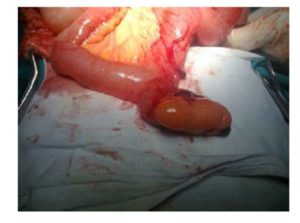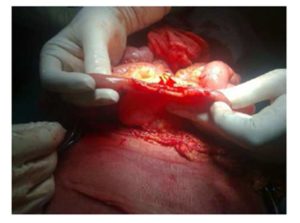Introduction
Meckel’s diverticulum is a congenital anomaly that results from an incomplete obliteration of the vitello-intestinal duct. This may give rise to bleeding, intestinal obstruction and inflammation. Traumatic rupture of Meckel’s diverticulum has been reported previously in few instances in adult patients [1]. In children perforation of Meckel’s diverticulum has been reported from ulceration related to ectopic gastric mucosa in the diverticulum and from injury secondary to ingested foreign bodies, but rarely as a consequence of blunt abdominal trauma [2].
Case Report
A 10 yr old male child presented to the emergency with the history of blunt trauma to left lower abdomen with bicycle handle a day prior. The patient complained of generalized abdominal pain. There was no history of vomiting, constipation or obstipation. No history of fever or abdominal pain prior to the history of trauma to the abdomen. On physical examination the patient had tachycardia 110/min with the blood pressure of 100/70mmhg.There was generalized abdominal tenderness and guarding. On per rectum examination stools were present. Total WBC count was 10,000/cumm. The x-ray of abdomen showed pneumo-peritoneum. On emergency exploration through midline incision, there was no contamination of peritoneal cavity. A broad based, non inflammatory Meckels diverticulum was found. Complete small intestine and large intestine was examined but there was no perforation found .On careful examination of the Meckels diverticulum there was a small perforation around one millimeter size at the tip of the diverticulum. Wedge resection of the diverticulum with primary suturing was done. Post operative course was uneventful.
Discussion
Blunt abdominal trauma has been frequently noted in seat belt wearers with small bowel injuries the most common accounting for 1-7% of intra abdominal injuries in children. Injuries to jejunum are most common, followed by ileum, duodenum, colon and stomach. Blunt small bowel injuries may be very difficult to diagnose and often present on a delayed basis [1-4].The mechanism of Meckels diverticulum perforation in this report appears to be from the bicycle handlebar being a vector for transmitting energy through the abdominal wall and tearing the tip of the Meckels from a point of fixation to the small bowel mesentery 5.Our review of literature found only 4 published cases [1-6]. Diagnosis of Hollow visceral injuries in blunt abdominal trauma presents a significant challenge to the trauma team if patient does not present with clinical features of peritonitis. It is easy to diagnose hollow viscus injury in a conscious patient with clinically acute abdomen and also in the presence of free air in peritoneal cavity visualised on X-ray chest with both domes of diaphragm in sitting or standing position of patient and left lateral decubitus position if patient is unable to stand or sit. Conservative management of blunt abdominal trauma may increases the risk of delay in the diagnosis of hollow viscous injuries. Despite the clinical suspicion, diagnosis of hollow viscus injury is often delayed in children. This is an especially when there is associated head injury, spinal injury and solid organ abdominal injuries. This is largely due to its contribution in altering peritoneal signs [7]. In minimally symptomatic patient and conditions mentioned above requires a more aggressive approach to establish the diagnosis. CT scan is the investigation of choice in the hemodynamically stable patient [8]. Jamieson et al in a series of 34 CT studies in blunt abdominal trauma concluded that CT had 100% positive predictive value for bowel perforation when extra-luminal air, free fluid, wall thickening, bowel wall enhancement and bowel dilatation are present on CT [9]. In our trauma centre we do not advise CT scan if there is free air in peritoneum on X-ray findings because these patients require urgent exploration for bowel injury and intra-operatively all other organs can be visualised. The patients who are unstable and suspected hollow viscous injury or haemoperitoneum due to solid organ injury and cannot be shifted to radiology suite for CT scan, then we recommend diagnostic peritoneal lavage and if peritoneal lavage is positive for faecal, bile or blood effluent then patient is taken for emergency exploratory laparotomy. This has helped in reducing delayed diagnosis of hollow viscus injury in unstable and multi-organ injury patient.
Conclusion
If we find a Meckels diverticulum in a blunt abdominal trauma with pneumoperitoneum, we should not only examine the small and large bowel completely for perforation but also the diverticulum should be thoroughly examined so that a small perforation at the tip of the diverticulum is not missed.
References
1. Sager J, Kumar V, Shah DK. Meckel’s diverticulum: a systemic review. J R Soc Med. 2006; 99:501—505
Google Scholar
2. McAneny D, Rapo SE, Grindlinger GA: Traumatic hemoperitoneum due to a Meckel’s mesodiverticular band: case report. J Trauma 1989; 29: 261—26
Google Scholar
3. Jelenec F, Strilic M, Guardijancic D. Meckel’s Diverticulum with intra abdominal haemorhage. J Ped Surg 2002; 37:18.
4. Kennith H, Sartorelli, Christopher Healy Anthony Deross. Perforated Meckels Diverticulum in a child after blunt abdominal trauma. J Trauma 2007; 63:1167-1168
Google Scholar
5. Chalenko VV, Medvedev AN. Blunt abdominal trauma with injury of a Meckels diverticulum. Klin Khir 2007; 4: 62-63
6. Kourosh Kazemi, Hamed Jalaeian, Mohammad Reza Fattahi et al. Ruptured Meckel’s Mesodiverticulum and Meckel’s Diverticulum following Blunt Abdominal Trauma . Med Princ Pract 2008; 17:161—163
Publisher – Google Scholar
7. Neugebaur H, Wallenboeck E, Hungerford M. Seventy cases of injuries of the small intestine caused by blunt abdominal trauma: a retrospective study from 1970 to1994. J Trauma. 1999; 46: 116—21.
Publisher – Google Scholar
8. Jameison DH, Babyn PS, Pearl R. Imaging of gastrointestinal perforation in pediatric blunt abdominal trauma. Pediatric Radiology. 1996; 26: 188—194.
Publisher – Google Scholar
9. Rance CH, Singh SJ, Kimble R. Blunt abdominal injury in children. J Paediatr Child Health. 2000; 36: 2—6.
Publisher – Google Scholar





